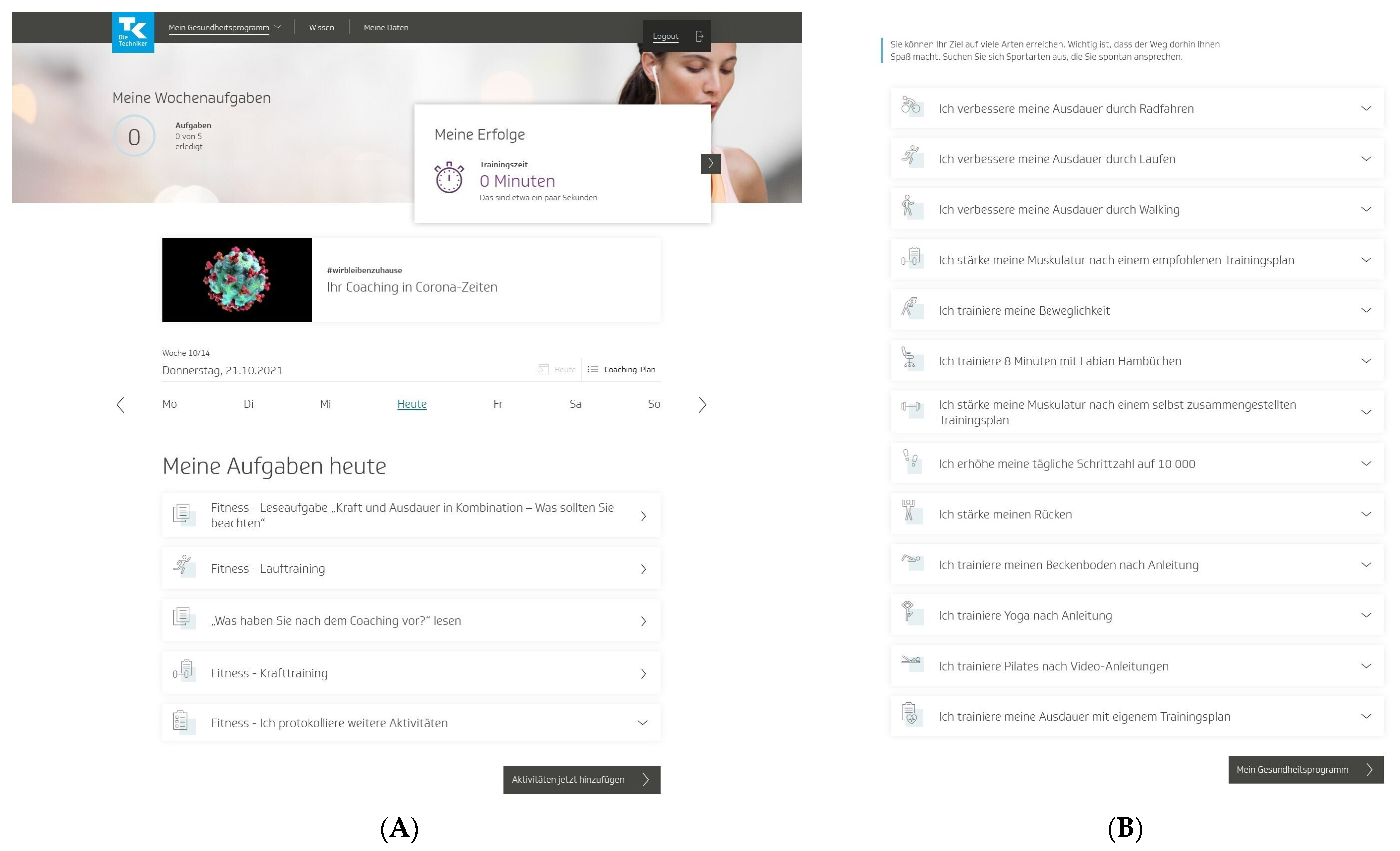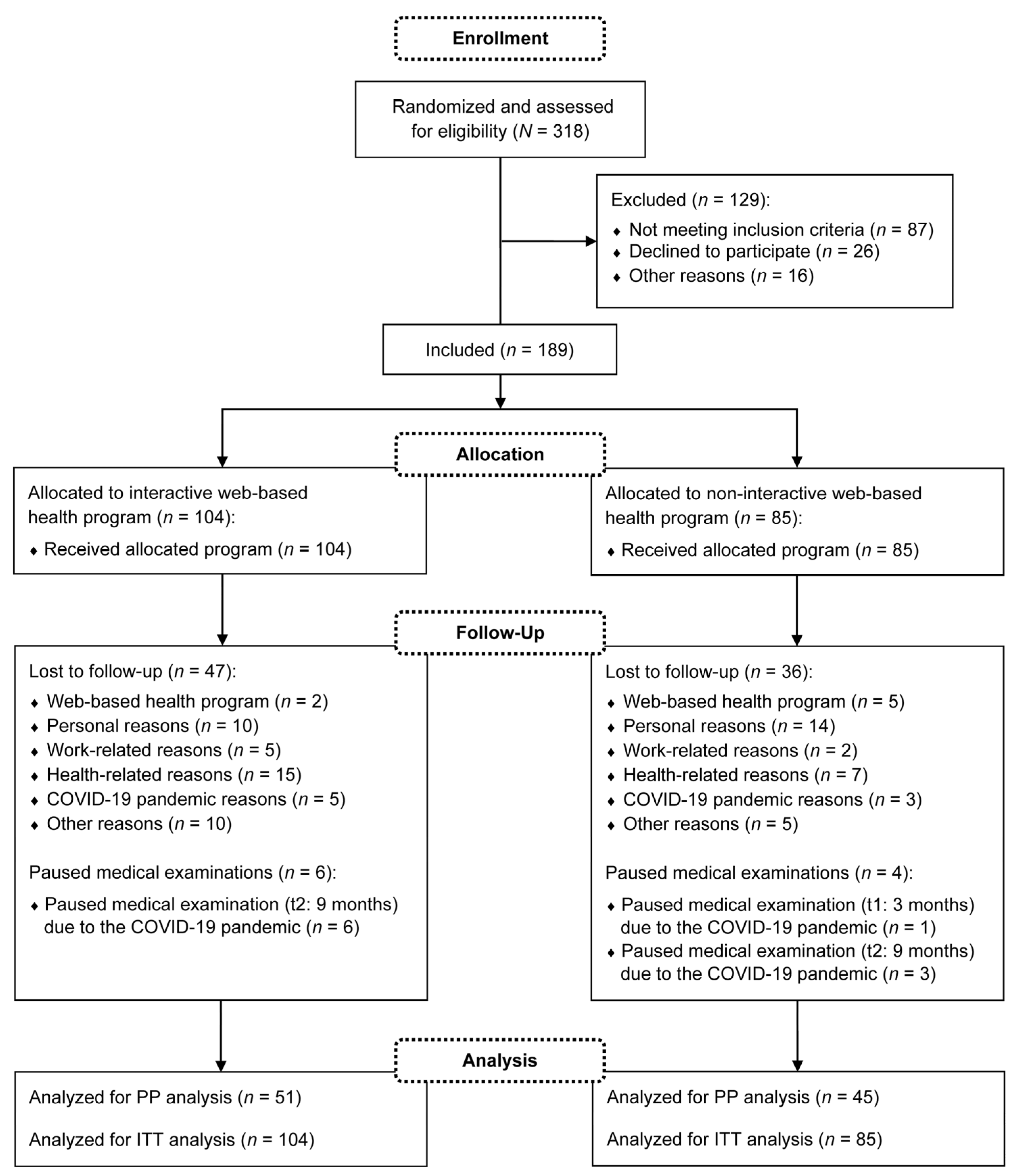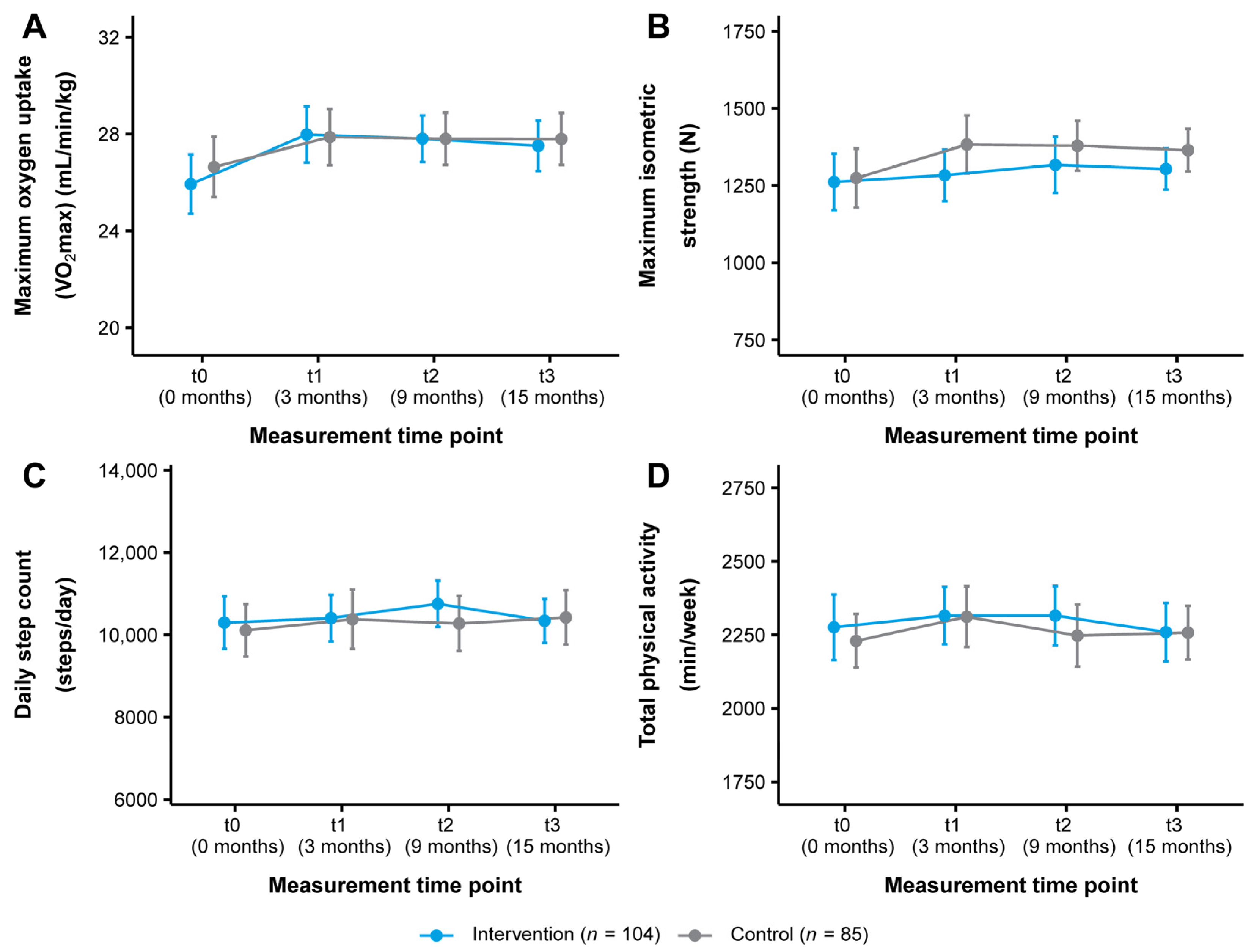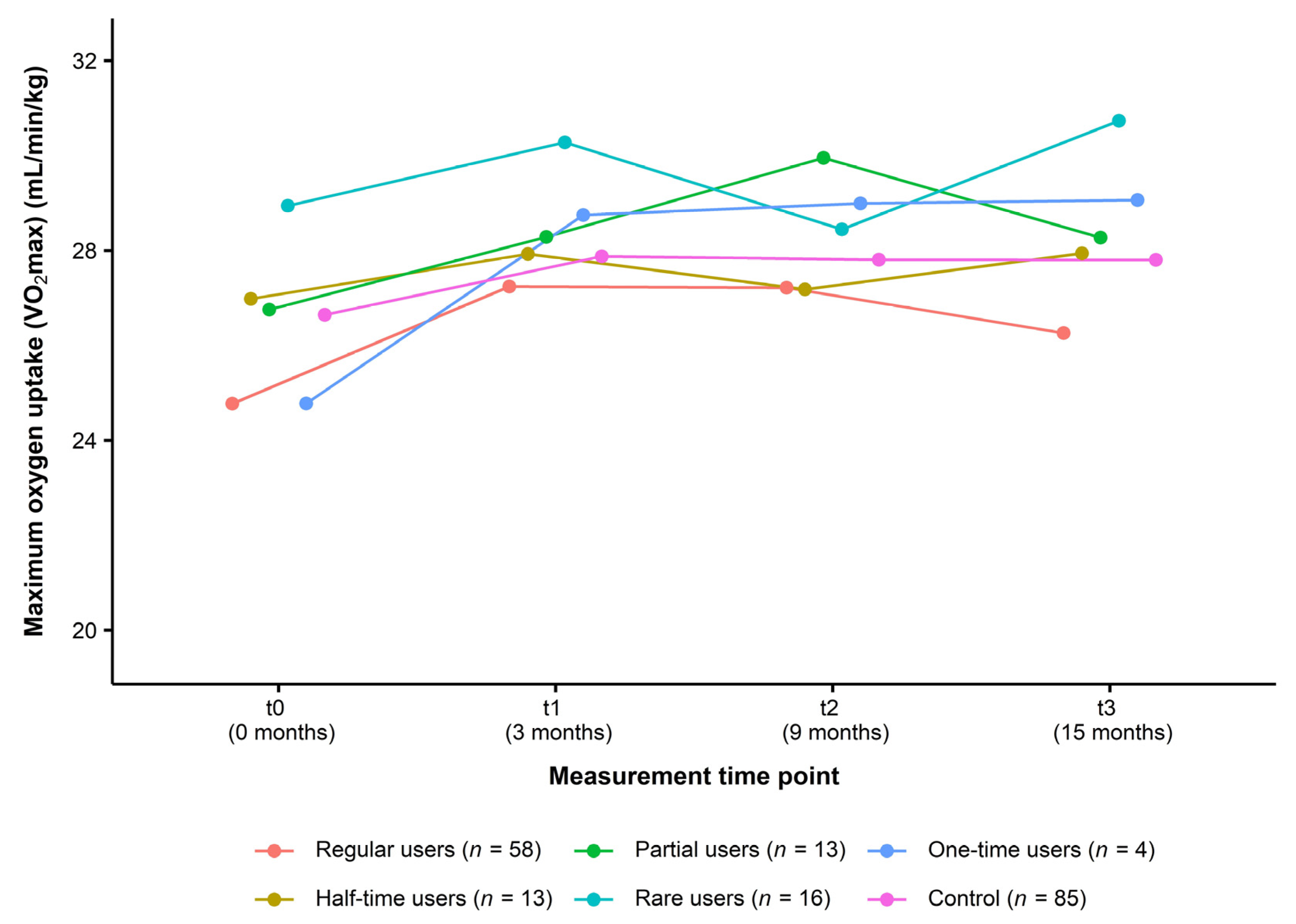Effects of a Web-Based Lifestyle Intervention on Physical Fitness and Health in Physically Inactive Adults: A Randomized Controlled Trial
Abstract
:1. Introduction
2. Materials and Methods
2.1. Study Design
2.2. Participants
2.3. Interventions
2.3.1. Interactive Web-Based Health Program
2.3.2. Non-Interactive Web-Based Health Program
2.4. Outcomes
2.4.1. Primary Outcome
Cardiorespiratory Fitness
2.4.2. Secondary Outcomes
Musculoskeletal Fitness
Physical Activity and Dietary Behavior
Physiological health outcomes
2.4.3. Other Outcomes
2.5. Sample Size
2.6. Randomization
2.7. Blinding
2.8. Statistical Methods
2.9. Data Management
3. Results
3.1. Participants
3.2. Primary Outcome
Cardiorespiratory Fitness
3.3. Secondary Outcomes
3.3.1. Musculoskeletal Fitness
3.3.2. Physical Activity and Dietary Behavior
3.3.3. Physiological Health Outcomes
3.4. Other Outcomes
4. Discussion
5. Conclusions
Supplementary Materials
Author Contributions
Funding
Institutional Review Board Statement
Informed Consent Statement
Data Availability Statement
Acknowledgments
Conflicts of Interest
Abbreviations
References
- World Health Organization. Noncommunicable Diseases: Risk Factors. Available online: https://www.who.int/data/gho/data/themes/topics/noncommunicable-diseases-risk-factors (accessed on 27 September 2023).
- Katzmarzyk, P.T.; Friedenreich, C.; Shiroma, E.J.; Lee, I.-M. Physical inactivity and non-communicable disease burden in low-income, middle-income and high-income countries. Br. J. Sports Med. 2022, 56, 101–106. [Google Scholar] [CrossRef]
- Guthold, R.; Stevens, G.A.; Riley, L.M.; Bull, F.C. Worldwide trends in insufficient physical activity from 2001 to 2016: A pooled analysis of 358 population-based surveys with 1·9 million participants. Lancet Glob. Health 2018, 6, e1077–e1086. [Google Scholar] [CrossRef] [PubMed]
- World Health Organization. WHO Guidelines on Physical Activity and Sedentary Behaviour; World Health Organization: Geneva, Switzerland, 2020; ISBN 978-92-4-001512-8.
- World Health Organization. Global Status Report on Physical Activity 2022; World Health Organization: Geneva, Switzerland, 2022; ISBN 978-92-4-005915-3.
- Bouchard, C.; Blair, S.N.; William, L. Physical Activity and Health, 2nd ed.; Human Kinetics: Champaign, IL, USA, 2012; ISBN 978-0-7360-9541-9. [Google Scholar]
- Hardman, A.; Stensel, D.J. Physical Activity and Health: The Evidence Explained, 2nd ed.; Routledge: Abingdon, Oxfordshire, UK, 2009; ISBN 978-0-415-42198-0. [Google Scholar]
- Kohl, H.W., III; Murray, T.D.; Salvo, D. Foundations of Physical Activity and Public Health, 2nd ed.; Human Kinetics: Champaign, IL, USA, 2020; ISBN 978-1-4925-8997-6. [Google Scholar]
- Semlitsch, T.; Stigler, F.L.; Jeitler, K.; Horvath, K.; Siebenhofer, A. Management of overweight and obesity in primary care—A systematic overview of international evidence-based guidelines. Obes. Rev. 2019, 20, 1218–1230. [Google Scholar] [CrossRef]
- ElSayed, N.A.; Aleppo, G.; Aroda, V.R.; Bannuru, R.R.; Brown, F.M.; Bruemmer, D.; Collins, B.S.; Hilliard, M.E.; Isaacs, D.; Johnson, E.L.; et al. 5. Facilitating Positive Health Behaviors and Well-being to Improve Health Outcomes: Standards of Care in Diabetes—2023. Diabetes Care 2023, 46, S68–S96. [Google Scholar] [CrossRef] [PubMed]
- Grundy, S.M.; Cleeman, J.I.; Daniels, S.R.; Donato, K.A.; Eckel, R.H.; Franklin, B.A.; Gordon, D.J.; Krauss, R.M.; Savage, P.J.; Smith, S.C.; et al. Diagnosis and management of the metabolic syndrome: An American Heart Association/National Heart, Lung, and Blood Institute Scientific Statement. Circulation 2005, 112, 2735–2752. [Google Scholar] [CrossRef]
- Galani, C.; Schneider, H. Prevention and treatment of obesity with lifestyle interventions: Review and meta-analysis. Int. J. Public. Health 2007, 52, 348–359. [Google Scholar] [CrossRef] [PubMed]
- Chen, L.; Pei, J.-H.; Kuang, J.; Chen, H.-M.; Chen, Z.; Li, Z.-W.; Yang, H.-Z. Effect of lifestyle intervention in patients with type 2 diabetes: A meta-analysis. Metabolism 2015, 64, 338–347. [Google Scholar] [CrossRef] [PubMed]
- Yamaoka, K.; Tango, T. Effects of lifestyle modification on metabolic syndrome: A systematic review and meta-analysis. BMC Med. 2012, 10, 138. [Google Scholar] [CrossRef]
- Müller, A.M.; Maher, C.A.; Vandelanotte, C.; Hingle, M.; Middelweerd, A.; Lopez, M.L.; DeSmet, A.; Short, C.E.; Nathan, N.; Hutchesson, M.J.; et al. Physical Activity, Sedentary Behavior, and Diet-Related eHealth and mHealth Research: Bibliometric Analysis. J. Med. Internet Res. 2018, 20, e122. [Google Scholar] [CrossRef]
- Griffiths, F.; Lindenmeyer, A.; Powell, J.; Lowe, P.; Thorogood, M. Why Are Health Care Interventions Delivered Over the Internet? A Systematic Review of the Published Literature. J. Med. Internet Res. 2006, 8, e10. [Google Scholar] [CrossRef]
- ITU. Schätzung zur Anzahl der Internetnutzer Weltweit für die Jahre 2005 bis 2023 (in Millionen) [Graph]. Statista. Available online: https://de.statista.com/statistik/daten/studie/805920/umfrage/anzahl-der-internetnutzer-weltweit/ (accessed on 16 October 2023).
- Bennett, G.G.; Glasgow, R.E. The delivery of public health interventions via the Internet: Actualizing their potential. Annu. Rev. Public. Health 2009, 30, 273–292. [Google Scholar] [CrossRef]
- Murray, E. Web-Based Interventions for Behavior Change and Self-Management: Potential, Pitfalls, and Progress. Medicine 2.0 2012, 1, e3. [Google Scholar] [CrossRef]
- Jahangiry, L.; Farhangi, M.A.; Shab-Bidar, S.; Rezaei, F.; Pashaei, T. Web-based physical activity interventions: A systematic review and meta-analysis of randomized controlled trials. Public. Health 2017, 152, 36–46. [Google Scholar] [CrossRef] [PubMed]
- Davies, C.A.; Spence, J.C.; Vandelanotte, C.; Caperchione, C.M.; Mummery, W.K. Meta-analysis of internet-delivered interventions to increase physical activity levels. Int. J. Behav. Nutr. Phys. Act. 2012, 9, 52. [Google Scholar] [CrossRef]
- van den Berg, M.H.; Schoones, J.W.; Vliet Vlieland, T.P.M. Internet-Based Physical Activity Interventions: A Systematic Review of the Literature. J. Med. Internet Res. 2007, 9, e26. [Google Scholar] [CrossRef] [PubMed]
- Foster, C.; Richards, J.; Thorogood, M.; Hillsdon, M. Remote and web 2.0 interventions for promoting physical activity. Cochrane Database Syst. Rev. 2013, 9, CD010395. [Google Scholar] [CrossRef]
- Broekhuizen, K.; Kroeze, W.; van Poppel, M.N.M.; Oenema, A.; Brug, J. A systematic review of randomized controlled trials on the effectiveness of computer-tailored physical activity and dietary behavior promotion programs: An update. Ann. Behav. Med. 2012, 44, 259–286. [Google Scholar] [CrossRef] [PubMed]
- Hutchesson, M.J.; Rollo, M.E.; Krukowski, R.; Ells, L.; Harvey, J.; Morgan, P.J.; Callister, R.; Plotnikoff, R.; Collins, C.E. eHealth interventions for the prevention and treatment of overweight and obesity in adults: A systematic review with meta-analysis. Obes. Rev. 2015, 16, 376–392. [Google Scholar] [CrossRef]
- Sorgente, A.; Pietrabissa, G.; Manzoni, G.M.; Re, F.; Simpson, S.; Perona, S.; Rossi, A.; Cattivelli, R.; Innamorati, M.; Jackson, J.B.; et al. Web-Based Interventions for Weight Loss or Weight Loss Maintenance in Overweight and Obese People: A Systematic Review of Systematic Reviews. J. Med. Internet Res. 2017, 19, e229. [Google Scholar] [CrossRef]
- Joiner, K.L.; Nam, S.; Whittemore, R. Lifestyle interventions based on the diabetes prevention program delivered via eHealth: A systematic review and meta-analysis. Prev. Med. 2017, 100, 194–207. [Google Scholar] [CrossRef]
- Cotter, A.P.; Durant, N.; Agne, A.A.; Cherrington, A.L. Internet interventions to support lifestyle modification for diabetes management: A systematic review of the evidence. J. Diabetes Complicat. 2014, 28, 243–251. [Google Scholar] [CrossRef] [PubMed]
- Kim, G.; Lee, J.-S.; Lee, S.-K. A Technology-Mediated Interventional Approach to the Prevention of Metabolic Syndrome: A Systematic Review and Meta-Analysis. Int. J. Environ. Res. Public. Health 2021, 18, 512. [Google Scholar] [CrossRef] [PubMed]
- Chen, D.; Ye, Z.; Shao, J.; Tang, L.; Zhang, H.; Wang, X.; Qiu, R.; Zhang, Q. Effect of electronic health interventions on metabolic syndrome: A systematic review and meta-analysis. BMJ Open 2020, 10, e036927. [Google Scholar] [CrossRef]
- Knaack, N.; Gauss, B.; Blieske, P. Mit digitalen Gesundheitszielen in ein gesundes Leben starten. In e-Health 2017: Informations-und Kommunikationstechnologien im Gesundheitswesen, 1st ed.; Duesberg, F., Ed.; Medical Future Verlag: Solingen, Germany, 2017; pp. 133–135. ISBN 978-3-9817097-2-8. [Google Scholar]
- Brame, J.; Kohl, J.; Wurst, R.; Fuchs, R.; Tinsel, I.; Maiwald, P.; Fichtner, U.; Armbruster, C.; Bischoff, M.; Farin-Glattacker, E.; et al. Health Effects of a 12-Week Web-Based Lifestyle Intervention for Physically Inactive and Overweight or Obese Adults: Study Protocol of Two Randomized Controlled Clinical Trials. Int. J. Environ. Res. Public. Health 2022, 19, 1393. [Google Scholar] [CrossRef] [PubMed]
- Tinsel, I.; Metzner, G.; Schlett, C.; Sehlbrede, M.; Bischoff, M.; Anger, R.; Brame, J.; König, D.; Wurst, R.; Fuchs, R.; et al. Effectiveness of an interactive web-based health program for adults: A study protocol for three concurrent controlled-randomized trials (EVA-TK-Coach). Trials 2021, 22, 526. [Google Scholar] [CrossRef]
- Eysenbach, G. CONSORT-EHEALTH: Improving and Standardizing Evaluation Reports of Web-based and Mobile Health Interventions. J. Med. Internet Res. 2011, 13, e126. [Google Scholar] [CrossRef] [PubMed]
- Fitbit Charge 3™; Activity Tracker; Fitbit, Inc.: San Francisco, CA, USA, 2018.
- Cooper, K.H. A Means of Assessing Maximal Oxygen Intake. JAMA 1968, 203, 201–204. [Google Scholar] [CrossRef]
- American College of Sports Medicine. ACSM’s Health-Related Physical Fitness Assessment Manual, 5th ed.; Wolters Kluwer: Philadelphia, PA, USA, 2018; ISBN 978-1496338808. [Google Scholar]
- Genius Eco® Funktionsstemme–Liegend/Sitzend–150 kg; Isometric Leg Press, FREI AG: Kirchzarten, Germany, 2014.
- ProFit Cube, Version 2.4.80; ProFit—Software für die Fitnessbranche: Erlangen, Germany, 2019.
- Jamar® Hydraulic Hand Dynamometer; Hand Dynamometer; Performance Health International LTD.: Huthwaite, UK, 2017.
- Craig, C.L.; Marshall, A.L.; Sjöström, M.; Bauman, A.E.; Booth, M.L.; Ainsworth, B.E.; Pratt, M.; Ekelund, U.; Yngve, A.; Sallis, J.F.; et al. International physical activity questionnaire: 12-country reliability and validity. Med. Sci. Sports Exerc. 2003, 35, 1381–1395. [Google Scholar] [CrossRef]
- Täger, M.; Peltner, J.; Thiele, S. Evaluation of diet quality by means of the Healthy Eating Index and its modified variants. Ernahr. Umsch. 2016, 63, 110–118. [Google Scholar] [CrossRef]
- Wittig, F.; Hoffmann, I. Ernährungsmuster von Bio-Käufern und Nicht-Bio-Käufern. In Auswertung der Daten der Nationalen Verzehrsstudie II (NVS II): Eine integrierte verhaltens- und lebensstilbasierte Analyse des Bio-Konsums; Hoffmann, I., Spiller, A., Eds.; Max Rubner-Institut: Karlsruhe, Germany; Georg-August-Universität: Göttingen, Germany, 2010; pp. 51–68. Available online: https://orgprints.org/id/eprint/18055/1/18055-08OE056_08OE069-MRI_uni-goettingen-hoffmann_spiller-2010-verzehrsstudie.pdf (accessed on 27 September 2023).
- NutriGuide®Plus, Version 4.8; Nutri-Science GmbH: Freiburg, Germany, 2019.
- Seca 274; Stadiometer; Seca GmbH & Co. KG: Hamburg, Germany, 2019.
- Seca mBCA 515; Bioelectrical Impedance Analysis Scale; Seca GmbH & Co. KG: Hamburg, Germany, 2019.
- Seca 201; Measuring Tape; Seca GmbH & Co. KG: Hamburg, Germany, 2011.
- Boso Medicus Exclusive; Electronic Blood Pressure Device; BOSCH + SOHN GmbH & Co. KG: Jungingen, Germany, 2019.
- AngioDefender™; Medical Device; Everist Genomics, Inc.: Ann Arbor, MI, USA, 2019.
- Vascular Age Calculator™, Version 4.0.8; Everist Health: Ann Arbor, MI, USA, 2020.
- Faul, F.; Erdfelder, E.; Lang, A.-G.; Buchner, A. G*Power 3: A flexible statistical power analysis program for the social, behavioral, and biomedical sciences. Behav. Res. Methods 2007, 39, 175–191. [Google Scholar] [CrossRef]
- Pahlke, F.; König, I.R.; Ziegler, A. Randomization In Treatment Arms (RITA): Ein Randomisierungs-Programm für klinische Studien. Inform. Biom. Epidemiol. Med. Bio. 2004, 35, 1–22. [Google Scholar]
- R Core Team. R: A Language and Environment for Statistical Computing, Version 4.0.5; R Foundation for Statistical Computing: Vienna, Austria, 2021.
- Koller, M. robustlmm: An R Package for Robust Estimation of Linear Mixed-Effects Models. J. Stat. Softw. 2016, 75, 1–24. [Google Scholar] [CrossRef]
- Ben-Shachar, M.; Lüdecke, D.; Makowski, D. effectsize: Estimation of Effect Size Indices and Standardized Parameters. J. Open Source Softw. 2020, 5, 2815. [Google Scholar] [CrossRef]
- Audigier, V.; Resche-Rigon, M. micemd: Multiple Imputation by Chained Equations with Multilevel Data, Version 1.8.0; R Package. 2021. Available online: https://CRAN.R-project.org/package=micemd (accessed on 28 July 2022).
- Ricci, F.; Izzicupo, P.; Moscucci, F.; Sciomer, S.; Maffei, S.; Di Baldassarre, A.; Mattioli, A.V.; Gallina, S. Recommendations for Physical Inactivity and Sedentary Behavior During the Coronavirus Disease (COVID-19) Pandemic. Front. Public. Health 2020, 8, 199. [Google Scholar] [CrossRef] [PubMed]
- Sallis, R.; Young, D.R.; Tartof, S.Y.; Sallis, J.F.; Sall, J.; Li, Q.; Smith, G.N.; Cohen, D.A. Physical inactivity is associated with a higher risk for severe COVID-19 outcomes: A study in 48 440 adult patients. Br. J. Sports Med. 2021, 55, 1099–1105. [Google Scholar] [CrossRef] [PubMed]
- Hansen, A.W.; Grønbæk, M.; Helge, J.W.; Severin, M.; Curtis, T.; Tolstrup, J.S. Effect of a Web-Based Intervention to Promote Physical Activity and Improve Health Among Physically Inactive Adults: A Population-Based Randomized Controlled Trial. J. Med. Internet Res. 2012, 14, e145. [Google Scholar] [CrossRef]
- Compernolle, S.; Vandelanotte, C.; Cardon, G.; de Bourdeaudhuij, I.; de Cocker, K. Effectiveness of a Web-Based, Computer-Tailored, Pedometer-Based Physical Activity Intervention for Adults: A Cluster Randomized Controlled Trial. J. Med. Internet Res. 2015, 17, e38. [Google Scholar] [CrossRef]
- Wijsman, C.A.; Westendorp, R.G.; Verhagen, E.A.; Catt, M.; Slagboom, P.E.; de Craen, A.J.; Broekhuizen, K.; van Mechelen, W.; van Heemst, D.; van der Ouderaa, F.; et al. Effects of a Web-Based Intervention on Physical Activity and Metabolism in Older Adults: Randomized Controlled Trial. J. Med. Internet Res. 2013, 15, e233. [Google Scholar] [CrossRef]
- Olds, T.S.; Gomersall, S.R.; Olds, S.T.; Ridley, K. A source of systematic bias in self-reported physical activity: The cutpoint bias hypothesis. J. Sci. Med. Sport. 2019, 22, 924–928. [Google Scholar] [CrossRef]
- Eysenbach, G. Issues in evaluating health websites in an Internet-based randomized controlled trial. J. Med. Internet Res. 2002, 4, e17. [Google Scholar] [CrossRef]
- Baker, T.B.; Gustafson, D.H.; Shaw, B.; Hawkins, R.; Pingree, S.; Roberts, L.; Strecher, V. Relevance of CONSORT reporting criteria for research on eHealth interventions. Patient Educ. Couns. 2010, 81, S77–S86. [Google Scholar] [CrossRef]
- Mayorga-Vega, D.; Bocanegra-Parrilla, R.; Ornelas, M.; Viciana, J. Criterion-Related Validity of the Distance- and Time-Based Walk/Run Field Tests for Estimating Cardiorespiratory Fitness: A Systematic Review and Meta-Analysis. PLoS ONE 2016, 11, e0151671. [Google Scholar] [CrossRef] [PubMed]
- Mathiowetz, V.; Weber, K.; Volland, G.; Kashman, N. Reliability and validity of grip and pinch strength evaluations. J. Hand Surg. Am. 1984, 9, 222–226. [Google Scholar] [CrossRef]
- Marschall, F.; Gail, S. Standardisierung eines Testprotokolls zur Bestimmung der isometrischen Maximalkraft. Beweg. Gesundh. 2011, 27, 226–230. [Google Scholar] [CrossRef]
- Baker, D.; Wilson, G.; Carlyon, B. Generality versus specificity: A comparison of dynamic and isometric measures of strength and speed-strength. Eur. J. Appl. Physiol. Occup. Physiol. 1994, 68, 350–355. [Google Scholar] [CrossRef] [PubMed]
- Ringeval, M.; Wagner, G.; Denford, J.; Paré, G.; Kitsiou, S. Fitbit-Based Interventions for Healthy Lifestyle Outcomes: Systematic Review and Meta-Analysis. J. Med. Internet Res. 2020, 22, e23954. [Google Scholar] [CrossRef]
- Evenson, K.R.; Goto, M.M.; Furberg, R.D. Systematic review of the validity and reliability of consumer-wearable activity trackers. Int. J. Behav. Nutr. Phys. Act. 2015, 12, 159. [Google Scholar] [CrossRef] [PubMed]
- Feehan, L.M.; Geldman, J.; Sayre, E.C.; Park, C.; Ezzat, A.M.; Yoo, J.Y.; Hamilton, C.B.; Li, L.C. Accuracy of Fitbit Devices: Systematic Review and Narrative Syntheses of Quantitative Data. JMIR Mhealth Uhealth 2018, 6, e10527. [Google Scholar] [CrossRef]
- St Fleur, R.G.; St George, S.M.; Leite, R.; Kobayashi, M.; Agosto, Y.; Jake-Schoffman, D.E. Use of Fitbit Devices in Physical Activity Intervention Studies Across the Life Course: Narrative Review. JMIR Mhealth Uhealth 2021, 9, e23411. [Google Scholar] [CrossRef]
- Wilke, J.; Rahlf, A.L.; Füzéki, E.; Groneberg, D.A.; Hespanhol, L.; Mai, P.; de Oliveira, G.M.; Robbin, J.; Tan, B.; Willwacher, S.; et al. Physical Activity During Lockdowns Associated with the COVID-19 Pandemic: A Systematic Review and Multilevel Meta-analysis of 173 Studies with 320,636 Participants. Sports Med. Open 2022, 8, 125. [Google Scholar] [CrossRef]
- Chen, P.; Mao, L.; Nassis, G.P.; Harmer, P.; Ainsworth, B.E.; Li, F. Coronavirus disease (COVID-19): The need to maintain regular physical activity while taking precautions. J. Sport. Health Sci. 2020, 9, 103–104. [Google Scholar] [CrossRef] [PubMed]




| Variable | Total (n = 189) | Intervention (n = 104) | Control (n = 85) | p-Value |
|---|---|---|---|---|
| Age (years) | 48.07 ± 12.01 | 48.36 ± 11.65 | 47.73 ± 12.49 | 0.722 |
| Gender (n) | ||||
| Male | 50 (26.50) | 28 (26.90) | 22 (25.90) | 0.872 |
| Female | 139 (73.50) | 76 (73.10) | 63 (74.10) | |
| Body weight (kg) | 74.65 ± 13.70 | 74.99 ± 13.01 | 74.24 ± 14.57 | 0.713 |
| Body height (m) | 1.70 ± 0.08 | 1.70 ± 0.08 | 1.71 ± 0.08 | 0.523 |
| BMI (kg/m2) | 25.56 ± 3.66 | 25.85 ± 3.50 | 25.19 ± 3.84 | 0.216 |
| Group | t0 (0 Months) | t1 (3 Months) | t2 (9 Months) | t3 (15 Months) |
|---|---|---|---|---|
| Maximum oxygen uptake (VO2max) (mL/min/kg) | ||||
| Intervention | 25.94 ± 6.29 | 27.98 ± 5.95 | 27.81 ± 4.94 | 27.52 ± 5.38 |
| Control | 26.64 ± 5.77 | 27.88 ± 5.37 | 27.80 ± 4.98 | 27.80 ± 4.96 |
| Maximum isometric strength (leg press) (N) | ||||
| Intervention | 1261.85 ± 473.62 | 1283.36 ± 430.61 | 1317.15 ± 466.86 | 1303.67 ± 342.26 |
| Control | 1274.11 ± 441.60 | 1382.98 ± 438.19 | 1378.98 ± 375.60 | 1364.77 ± 319.69 |
| Maximum isometric strength (hand grip) (kg) | ||||
| Intervention | 39.85 ± 11.24 | 39.21 ± 9.03 | 40.24 ± 9.17 | 40.57 ± 8.38 |
| Control | 39.58 ± 9.82 | 39.42 ± 9.11 | 41.08 ± 7.87 | 41.82 ± 8.14 |
| Group | t0–t1 (0–3 Months) | t0–t2 (0–9 Months) | t0–t3 (0–15 Months) |
|---|---|---|---|
| Maximum oxygen uptake (VO2max) (mL/min/kg) | |||
| Intervention | 0.33 [0.06, 0.61] | 0.33 [0.06, 0.64] | 0.27 [−0.00, 0.54] |
| Control | 0.22 [−0.08, 0.52] | 0.22 [−0.09, 0.52] | 0.22 [−0.09, 0.52] |
| Maximum isometric strength (leg press) (N) | |||
| Intervention | 0.05 [−0.22, 0.32] | 0.12 [−0.16, 0.39] | 0.10 [−0.17, 0.37] |
| Control | 0.25 [−0.06, 0.55] | 0.26 [−0.05, 0.56] | 0.24 [−0.07, 0.54] |
| Maximum isometric strength (hand grip) (kg) | |||
| Intervention | −0.06 [−0.33, 0.21] | 0.04 [−0.23, 0.31] | 0.07 [−0.20, 0.35] |
| Control | −0.02 [−0.32, 0.28] | 0.17 [−0.13, 0.47] | 0.25 [−0.05, 0.55] |
| Predictors | Maximum Oxygen Uptake (VO2max) (mL/min/kg) | Maximum Isometric Strength (Leg Press) (N) | Maximum Isometric Strength (Hand Grip) (kg) | |||
|---|---|---|---|---|---|---|
| Estimate | p-Value | Estimate | p-Value | Estimate | p-Value | |
| (Intercept) | 25.03 ± 1.36 | <0.001 * | 1206.50 ± 93.98 | <0.001 * | 37.59 ± 1.95 | <0.001 * |
| Time | ||||||
| t0–t1 (0–3 months) | 2.65 ± 1.12 | 0.018 * | −18.70 ± 92.77 | 0.840 | −0.32 ± 1.73 | 0.854 |
| t0–t2 (0–9 months) | 2.47 ± 1.28 | 0.055 | 1.35 ± 94.84 | 0.989 | −0.27 ± 1.77 | 0.880 |
| t0–t3 (0–15 months) | 1.83 ± 1.54 | 0.236 | 34.09 ± 107.97 | 0.752 | −0.00 ± 1.93 | 1.000 |
| Group (control) | 0.71 ± 0.88 | 0.425 | 11.20 ± 61.55 | 0.856 | 0.52 ± 1.27 | 0.681 |
| Time * group (control) | ||||||
| t0–t1 (0–3 months) | −0.70 ± 0.71 | 0.326 | 67.31 ± 59.95 | 0.262 | 0.05 ± 1.11 | 0.967 |
| t0–t2 (0–9 months) | −0.70 ± 0.84 | 0.401 | 58.68 ± 61.99 | 0.344 | 0.82 ± 1.19 | 0.492 |
| t0–t3 (0–15 months) | −0.29 ± 1.05 | 0.786 | 31.71 ± 69.54 | 0.649 | 1.20 ± 1.26 | 0.341 |
| Group | t0 (0 Months) | t1 (3 Months) | t2 (9 Months) | t3 (15 Months) |
|---|---|---|---|---|
| Maximum oxygen uptake (VO2max) (mL/min/kg) | ||||
| Intervention | ||||
| Regular users | 24.77 ± 5.30 | 27.24 ± 5.96 | 27.22 ± 5.01 | 26.26 ± 4.78 |
| Half-time users | 26.98 ± 6.31 | 27.93 ± 5.96 | 27.18 ± 5.37 | 27.94 ± 4.27 |
| Partial users | 26.75 ± 6.78 | 28.28 ± 7.22 | 29.95 ± 2.83 | 28.27 ± 7.64 |
| Rare users | 28.94 ± 8.26 | 30.28 ± 5.39 | 28.44 ± 5.93 | 30.73 ± 5.59 |
| One-time users | 24.77 ± 7.52 | 28.75 ± 2.65 | 28.99 ± 2.41 | 29.06 ± 2.01 |
| Control | 26.64 ± 5.77 | 27.88 ± 5.37 | 27.80 ± 4.98 | 27.80 ± 4.96 |
Disclaimer/Publisher’s Note: The statements, opinions and data contained in all publications are solely those of the individual author(s) and contributor(s) and not of MDPI and/or the editor(s). MDPI and/or the editor(s) disclaim responsibility for any injury to people or property resulting from any ideas, methods, instructions or products referred to in the content. |
© 2023 by the authors. Licensee MDPI, Basel, Switzerland. This article is an open access article distributed under the terms and conditions of the Creative Commons Attribution (CC BY) license (https://creativecommons.org/licenses/by/4.0/).
Share and Cite
Brame, J.; Kohl, J.; Centner, C.; Wurst, R.; Fuchs, R.; Tinsel, I.; Maiwald, P.; Fichtner, U.A.; Sehlbrede, M.; Farin-Glattacker, E.; et al. Effects of a Web-Based Lifestyle Intervention on Physical Fitness and Health in Physically Inactive Adults: A Randomized Controlled Trial. Healthcare 2023, 11, 2847. https://doi.org/10.3390/healthcare11212847
Brame J, Kohl J, Centner C, Wurst R, Fuchs R, Tinsel I, Maiwald P, Fichtner UA, Sehlbrede M, Farin-Glattacker E, et al. Effects of a Web-Based Lifestyle Intervention on Physical Fitness and Health in Physically Inactive Adults: A Randomized Controlled Trial. Healthcare. 2023; 11(21):2847. https://doi.org/10.3390/healthcare11212847
Chicago/Turabian StyleBrame, Judith, Jan Kohl, Christoph Centner, Ramona Wurst, Reinhard Fuchs, Iris Tinsel, Phillip Maiwald, Urs A. Fichtner, Matthias Sehlbrede, Erik Farin-Glattacker, and et al. 2023. "Effects of a Web-Based Lifestyle Intervention on Physical Fitness and Health in Physically Inactive Adults: A Randomized Controlled Trial" Healthcare 11, no. 21: 2847. https://doi.org/10.3390/healthcare11212847
APA StyleBrame, J., Kohl, J., Centner, C., Wurst, R., Fuchs, R., Tinsel, I., Maiwald, P., Fichtner, U. A., Sehlbrede, M., Farin-Glattacker, E., Gollhofer, A., & König, D. (2023). Effects of a Web-Based Lifestyle Intervention on Physical Fitness and Health in Physically Inactive Adults: A Randomized Controlled Trial. Healthcare, 11(21), 2847. https://doi.org/10.3390/healthcare11212847






